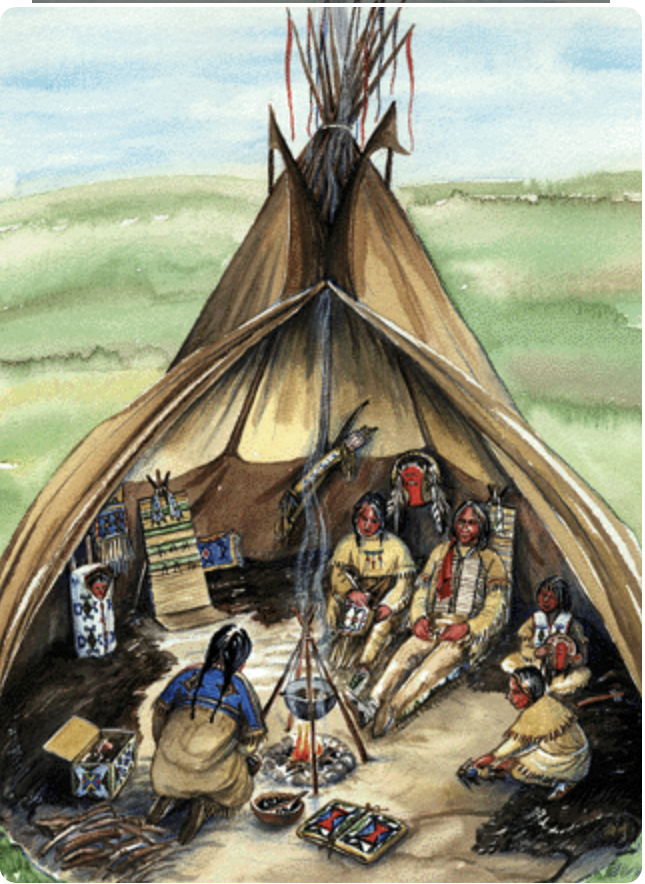How Did Indians Survive Brutal Winters?
- Notes From The Frontier
- Dec 10, 2024
- 3 min read
Those of us who live in the northern half of the United States and in Canada have the luxury of modern heat during our brutal winters. But how did Native Americans survive the killing cold?
The winter months bring blizzards and raging winds and killing temperatures. But we sit in our heated homes and sleep in cozy beds under thick comforters. How did Indians survive the brutal winters, especially on the wind-swept open prairies and in the icy mountains?
Native Americans primarily stayed warm in the winter by wearing thick clothing and footwear made from hides and furs from animals available in their area. They layered them the hide clothing and furs to adapt to the temperature. They also utilized fire inside their dwellings, which were designed to retain heat from a central fire; different tribes adapted their strategies based on their environment and available resources, with some focusing on hunting animals like buffalo for their hides and others using materials like reeds and grass for insulation.

DWELLINGS
North American Indians stayed warm, first of all, by building dwellings made of materials from their natural environment: animals hides, animal furs, grasses, trees, barks, soil, clay, rocks, and ice. Often dwellings, like the longhouse, provided housing for many families, whose combined body heat helped to provide natural heat in a shelter.

TIPIS
Americans are most familiar with the iconic tipi, that was used widely by the Plains Indians. Tipis were made of long poles and animals hides, often of buffalo because the hide was very large and tough. The tipis could also be quite large and accommodate an entire family.
A tipi interior typically featured a small, centrally located fire pit in the middle of the tipi for central heat and cooking. The fire was directly under the smoke flap at the top of the tipi. The conical formation of the tipi, with the smoke hole at the top allow the smoke to rise and escape through the opening while providing warmth and light within the space with careful attention to ventilation to manage smoke buildup.
SEE LINK BELOW, "How to Build a Tipi," about how these amazing shelters were constructed and BOUT HOW NATIVE AMERICANS BUILT TIPIS.

Beds inside tipis were made of buffalo hides (among the Plains Indians) or other hides and blankets layered on top of piles of grass and hay—very light weight and easily packed up for traveling.
Native Americans often kept warm in the winter by heating rocks in a fire and then placing them inside their dwellings, particularly in their tipi shelters, to radiate heat throughout the space. Sometimes water was poured on the rocks to create steam, which also moisture in the air to protect against dry skin. Of course, this system was also used in sweat lodges. (SEE A FUTURE POST ABOUT SWEAT LODGES & THEIR PRACTICAL AND SPIRITUAL PURPOSES).

The Plains Indians often used dried buffalo dung, called "chips," to burn in their fires, as it was a readily available fuel source and trees were often scarce on the prairie.

ANIMAL HIDES & FURS
All Native tribes used animal hides and furs as clothing, footwear, blankets, coverings and insulation. Some of the warmest animal hides include:
Eskimos often used caribou for clothing and for their bedding. The hollow hairs of caribou trap air, which provides insulation and makes caribou skin clothing lightweight, durable, and water repellent.

They also used sea otter and sealskins are also considered one of the warmest animals furs on the planet and are also waterproof. Arctic fox was used and the white fur was valued. Bison fur is warmer and more durable than sheep's wool. Bull bison have thicker leather and longer, heavier fur, making them warmer.
Beaver fur is soft, velvety, and luxurious and also waterproof.
Wolf and coyote fur is long and dense and is considered prime winter fur.
Wolverine fur was sometimes worn around the neck and face because the fur is particularly good for shedding frost from a wearer's breath.

Related Posts You May Enjoy:
• How to Build A Tipi
• How to Build A Cabin
"How Did Indians Survive Brutal Winters?" was first posted on Facebook and Notes from the Frontier on December 6, 2024.
©2024 NOTES FROM THE FRONTIER







